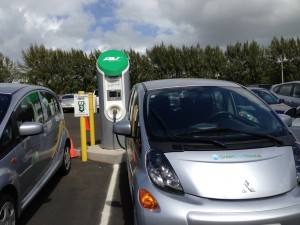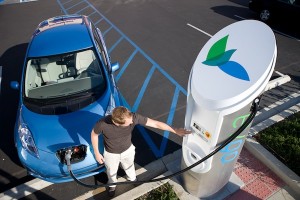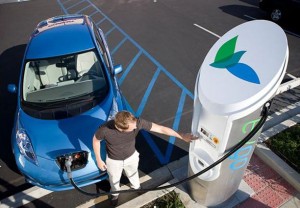Green Car Reports looked into it, and the numbers aren’t pretty. From a recent study of charging station hosts in North Carolina:
Host sites were responsible for both installation and operating costs, and electric-car drivers could charge for free.
The charging stations themselves were also provided free, but applicants still had to pay $20,000 to $60,000 to install them. That was cited as one of the reasons why–out of a pool of 16 applicants–only five sites ended up installing the fast-charging sites.
One factor that boosts costs for DC fast charging–as well as 240-Volt AC Level 2 charging–is digging a trench or otherwise connecting stations to a power source. In addition, DC fast charging comes with far higher power requirements–sometimes enough to trigger demand fees from utility companies.

Fast charger at the Kauai Hyatt — paid for with stimulus money but installed and operated by the hotel
Meanwhile, the revenue from these sites is typically not sufficient to cover costs. For example, the ideally located San Juan Capistrano fast-charging station between Los Angeles and San Diego only netted $10,000 in revenue over 18 months, with a $10-15 fee per hour of charging. That amount is not enough to cover operating costs, let alone pay back the cost of installation.
Perhaps site hosts with a retail shop can make up for it, as customers waiting to charge buy coffee or snacks like at a gas station convenience store. But you’d have to sell a lot of big gulps to break even.
To me, all of this adds up to the need for a serious look at having utilities enter the charging market, as California regulators are considering. Because otherwise, the numbers just aren’t there to encourage charging infrastructure at the scale we need.
Back in 2011, California regulators banned the state’s electric utilities from owning and operating electric vehicle charging equipment. Part of the logic was that utilities would crowd out innovation, using their monopoly power and capital resources to dominate the market.
 But so far, electric vehicle charging infrastructure in the state is rolling out poorly. eVgo, the company that received a $100 million state mandate to deploy charging infrastructure, is way behind schedule. Many existing charging stations are crowded and too few and far between, while the equipment is unreliable and often unavailable when you need it. Meanwhile, competing charging companies have developed cumbersome “networks” that you have to sign up for in order to access their chargers, instead of just having a simple, universal payment method like a gas station credit card reader.
But so far, electric vehicle charging infrastructure in the state is rolling out poorly. eVgo, the company that received a $100 million state mandate to deploy charging infrastructure, is way behind schedule. Many existing charging stations are crowded and too few and far between, while the equipment is unreliable and often unavailable when you need it. Meanwhile, competing charging companies have developed cumbersome “networks” that you have to sign up for in order to access their chargers, instead of just having a simple, universal payment method like a gas station credit card reader.
So is it time to call in the cavalry (i.e. utilities) to flood the market with cheap charging? San Diego Gas & Electric would certainly like to get that call. The company recently proposed a “pilot project” that looks more like a large-scale EV charging effort:
The [vehicle-grid integration] pilot is an “innovative hourly time-variant rate and associated grid-beneficial charging infrastructure,” SDG&E said, calling for authorization to develop 5,500 charging stations targeting multi-family dwellings and workplaces between 2015 and 2025. The VGI pilot would require approximately $59 million in capital costs and $44 million in operations and maintenance over the life of the project.
The California Public Utilities Commission has punted consideration of this pilot to the larger proceeding dealing with the question of electric utility involvement in charging more generally. That proceeding may issue a ruling in December.
From my perspective, the current charging infrastructure is inadequate and frustrating. Limited involvement by utilities might be welcome, provided that it’s done on a small scale to make sure we don’t unleash a beast. Perhaps the SDG&E pilot, or a smaller version of it, could be a good first step. The ultimate resolution of these issues will of course depend on careful fact-finding at the proceeding and input from stakeholders. But the bottom-line focus should be on the provision of cheap, reliable, ubiquitous, and easy-to-use charging for EV drivers.
I always feel guilty talking to apartment or condo dwellers about the joys of electric vehicles. Without a dedicated parking spot with access to an outlet, they’re basically out of luck. Maybe if you have workplace charging, you can make it work. But otherwise, it would be unwieldy to have to rely on a spread-out public charging network to keep your vehicle battery full.
But there may be a way to blanket urban areas with EV charging spots. The answer? Streetlights. Cities already have extensive wiring in place for these lights, and they’re not used during the day. So that excess capacity could be harnessed to install street chargers without requiring expensive and invasive electrical work. A few companies seem to be all over this possibility, just based on a quick Google search.
Of course, there would be challenges to work out. For example, how do you ensure that the chargers are only active during the day or when there is excess capacity on the streetlight grid? Installing LEDs and other efficient lighting technology could help at night to free up capacity (assuming the lamps aren’t already more efficient), but daytime may not be the optimal time to charge for daytime workers who may be gone then. And who pays for the install? Is there a viable business model where the chargers earn enough to cover the installation and maintenance costs?
These are just a few questions that spring to mind. But it’s an intriguing possibility that would help solve the otherwise seemingly intractable problem of providing ubiquitous charging in compact urban environments — and therefore opening the EV market to a whole new segment of potential buyers.
 Back in 2000, rolling blackouts descended upon California and eventually cost Governor Gray Davis his job. The crisis was caused by deviant corporate behavior, and one of the companies involved, NRG, finally settled with the state in 2012 for damages related to its conduct. But instead of being punished, the California Public Utilities Commission allowed NRG to commit to spending $100 million on electric vehicle public charging infrastructure, essentially helping the company invest in a new business venture.
Back in 2000, rolling blackouts descended upon California and eventually cost Governor Gray Davis his job. The crisis was caused by deviant corporate behavior, and one of the companies involved, NRG, finally settled with the state in 2012 for damages related to its conduct. But instead of being punished, the California Public Utilities Commission allowed NRG to commit to spending $100 million on electric vehicle public charging infrastructure, essentially helping the company invest in a new business venture.
It was a controversial bargain, but the upshot for the state was a big injection of capital into badly needed electric vehicle infrastructure. With 65,000 electric vehicles now on the road in California, the competition is increasing for charging stations. The NRG settlement would result in at least 200 new publicly available fast-charging stations around the state, as well as wiring for 10,000 more charging stations in offices, homes, and other public and private spaces.
So how is implementation going? Not well. NRG’s new subsidiary to build these stations, eVgo, is way behind schedule, with only 13 fast-charging stations open out of the 200 that need to be ready by 2016, with 100 of those to be open by the end of this year under the settlement terms. The company cites the startup pains associated with trying to get new infrastructure built – finding amenable site hosts, upgrading local utility wiring and equipment, and clearing the necessary permits. They believe they will make up for lost time this year.
But much of the reason for the delay is the basic conflict of interest involved in this settlement, which allows eVgo to site charging stations in crowded, complicated, and suboptimal urban areas in order to maximize the company’s profits. To be truly effective, expensive fast-charging stations (which can repower a battery to 80% capacity in just 20 minutes) should instead be located between cities and popular destinations, replicating the interstate gas stations drivers rely on for longer trips. These sites allow drivers to extend the range of their all-battery vehicles when they’re driving between cities like San Francisco and Sacramento, Los Angeles and San Diego/Palm Springs/Santa Barbara, or Fresno to Bakersfield, to name a few. For a good example of successful (and speedy) fast-charger deployment, look no further than Tesla and its optimally located Supercharger network along well-traveled interstates (enabling even an all-electric cross-country road trip).
On the other hand, fast-charging stations in urban areas tend to be a waste of money and counter-productive. Most city visitors live or work within 20 or 30 miles, meaning that a full charge over a regular wall outlet at the home or office should be sufficient to get them into the city and back in a typical 85 mile-range electric vehicle. And if they do need to charge downtown, these drivers usually don’t need a 20 minute fast charge because they are there to work or shop for at least one or two hours anyway. For this time frame, a cheaper “Level 2” 240V station will do just fine. What’s worse, crowded downtown fast chargers often require drivers to wait in line, defeating the purpose of a “fast” charge.
So why doesn’t eVgo/NRG follow this more sensible interstate model instead of trying to site their stations in suboptimal urban areas? Part of the answer lies in the settlement, which prescribes regions of the state for deployment. But the larger problem is that the company has a business interest in trying to make money off these stations through repeat customer membership deals and from patronage at nearby retail options. That’s why the company is working with upscale businesses, like Whole Foods and Urban Outfitters, and selling membership deals to hook local drivers into subscribing and becoming captive customers who will shop near the stations. This is a waste of charging infrastructure and a probable money-loser for NRG to boot.
If California was serious about making NRG pay for its rolling blackout damages and truly benefitting electric vehicle drivers, state leaders would insist that the fast-charging stations go in interstate locations, a la Tesla, to facilitate extended range for all-battery electric vehicle drivers. These locations should be the first priority, and they should blanket the state between our cities, not within them, and certainly not next to the local Whole Foods.
Were NRG representatives to take that approach, they’d find it a lot simpler to get these stations installed and ready. Sure, it wouldn’t help the company’s bottom line as much, but it would best serve the electric vehicle drivers of California.



